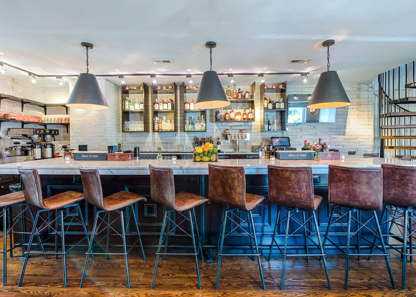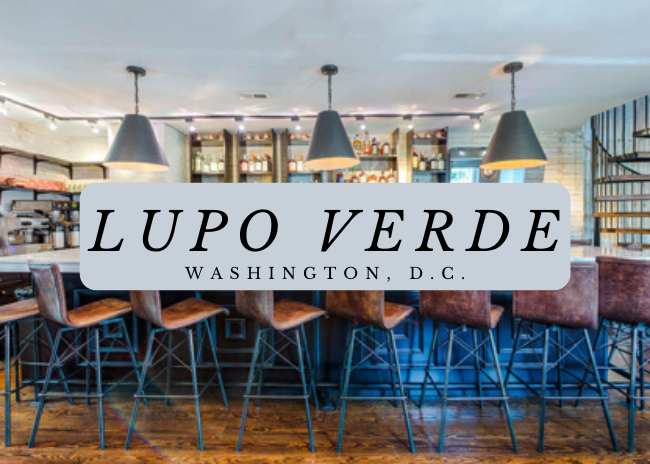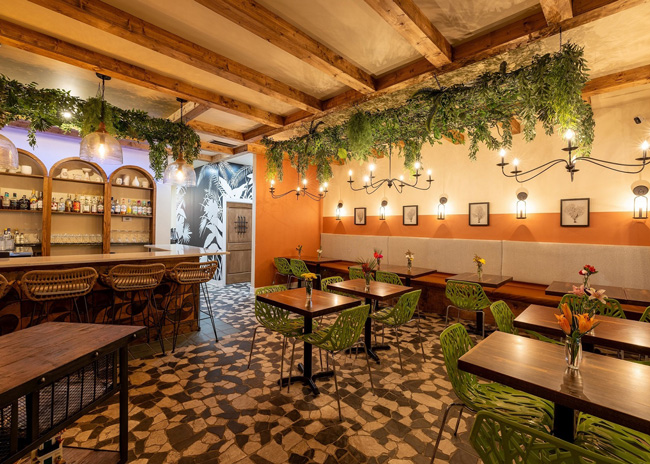Located in a three-level row house in Washington, D.C., Lupo Verde Osteria is owned by Med Lahlou, a prominent D.C. restaurateur. The operation’s interior was overseen by Tracy Morris, principal/owner of Tracy Morris Design.
According to Morris, one of Lahlou’s other operations is an Italian concept targeting Millennials, with a darker design and a focus on the bar. Lupo Verde is something of a counterpoint to that space, appealing to professionals.
Lupo Verde’s design, says Morris, is meant to be warm, comfortable and elegant. Materials include woods (in both the floor and as design elements, velvet and leathers, all lit with soft, warm lighting. “Basically they want you to come in and be enveloped by all the warmth, to sit and have a glass of wine or two and enjoy their homemade pasta.”
 Images courtesy of Lupo Verde.These ideas come through from the moment guests walk in the door. Like the rest of the main level, the entryway has hand-scraped oak wood floors stained a caramel color.
Images courtesy of Lupo Verde.These ideas come through from the moment guests walk in the door. Like the rest of the main level, the entryway has hand-scraped oak wood floors stained a caramel color.
To the left is a large display highlighting the wine program and to the right is a divider made of natural birch logs. These not only hint at the restaurant's wood-burning pizza oven, they also help separate the entrance from the dining area, says Morris.
“Because you’re walking right in off the street, we needed something that was going to serve as a barricade from the noise and the weather. We did not want to close off that particular wall so we decided to have these logs that create warmth. It allows the space to be open but private.”
Past the entry, guests encounter the bar and one of the restaurant's several dining spaces.
The bar, says Morris, is designed to be comfortable enough for guests to linger, enjoy their drinks and even full meals. “There are a lot of single professionals in this neighborhood, so they can go in alone and have dinner at the bar.”

This level of comfort is achieved through several design elements. The bar stools are upholstered in a warm brown leather and are numbered to avoid overcrowding, while the pendant lighting overhead gives off a soft, diffused light. “A lot of times you can sit in a bar or restaurant and have these harsh lights above your head. It feels like an interrogation room. These [fixtures] diffuse the light so it’s nice and soft and warm,” Morris says.
Also notable is the back bar. Many nearby restaurants, Morris says, serve only beer and wine. To highlight its full bar offering, the shelving for the liquor display was intentionally left open, allowing guests to see that spirits are on the menu.
The wall for the bar back, meanwhile is a subway tile with a brick texture, painted white. This was chosen over a brick veneer, which would have made the space too heavy given all the other warm, dark elements, she adds.
The restaurant’s second floor contains a general seating area as well as a private dining room.
The general dining area features a large section of banquette seating with a leather seat and velvet upholstered back in multiple colors. These colors, says Morris, are taken from several other design elements in the restaurant, helping to unify the space. “It makes you feel enveloped and pulls you in. It pulls it together in one fabric.”
The chairs paired with the banquette are Windsor style with a very wide, open back. This helps the space feel less closed in, according to Morris, while the lack of upholstery on the chairs makes the restaurant easier to clean and maintain in the long term.

The upstairs private dining room has a distinct set of furnishings, helping the space feel more special. Also standing out in this area is the fireplace, surrounded by sections of birch logs, while the dining room’s main wall is whitewashed brick.
 “Those were standard red bricks. Instead of having that be so heavy on that side, we decided to whitewash the brick and have the weight put in the fireplace wall. That gives the room a much more open feel,” Morris says.
“Those were standard red bricks. Instead of having that be so heavy on that side, we decided to whitewash the brick and have the weight put in the fireplace wall. That gives the room a much more open feel,” Morris says.
As a three-level restaurant, Lupo Verde located its kitchen on the bottom floor. The space is also home to a market, where customers can purchase fresh pasta, sauces and other Italian treats.
In the evening, this space can be converted to house a chef’s table with seating for 10, Morris says. To help enhance the experience, the window to the kitchen was extended out, allowing chefs to showcase the dishes they cook, says Morris.




.jpg)